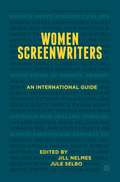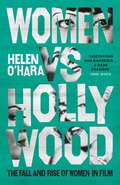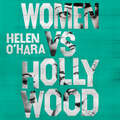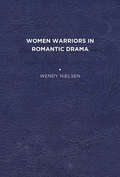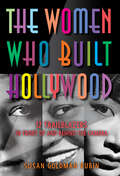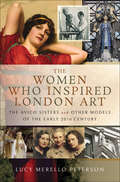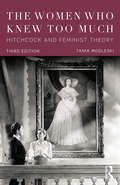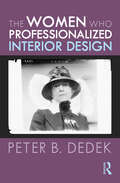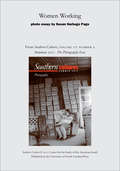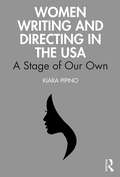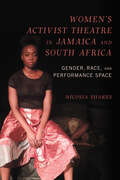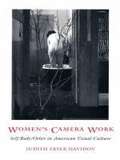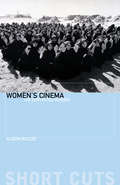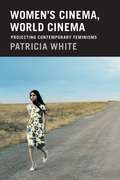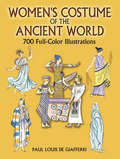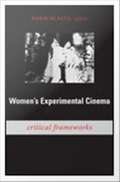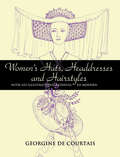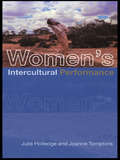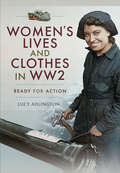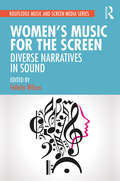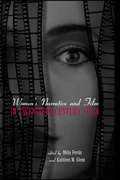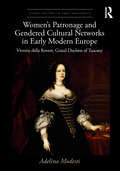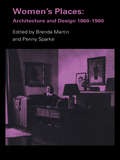- Table View
- List View
Women Screenwriters: An International Guide
by Jill Nelmes Jule SelboWomen Screenwriters is a study of more than 300 female writers from 60 nations, from the first film scenarios produced in 1986 to the present day. Divided into six sections by continent, the entries give an overview of the history of women screenwriters in each country, as well as individual biographies of its most influential.
Women vs Hollywood: The Fall and Rise of Women in Film
by Helen O'Hara'A fascinating polemic' Sunday Times 'A powerful, sobering and vital work' The Mail on Sunday 'A page-turning read, peppered with humour' Sight & Sound'A must read' Edgar Wright A call to arms from Empire magazine's 'geek queen', Helen O'Hara, that explores women's roles - both in front of and behind the camera - since the birth of Hollywood, how those roles are reflected within wider society and what we can do to level the playing field. Hollywood was born just over a century ago, at a time of huge forward motion for women's rights. With no rules in place to stop them, there were women who forged ahead in many areas of filmmaking. Yet, despite the work of early pioneers like Dorothy Arzner, Mabel Normand, Mary Pickford and Alice Guy-Blaché, it soon came to embody the same old sexist standards. Women found themselves fighting a system that fed on their talent, creativity and beauty but refused to pay them the same respect as their male contemporaries - until now . . . The tide has finally begun to turn. A new generation of women, both in front of and behind the camera, are making waves in the industry and are now shaping some of the biggest films to hit our screens. In Women vs Hollywood: The Fall and Rise of Women in Film, film critic Helen O'Hara takes a closer look at the pioneering and talented women of Hollywood and their work in film since Hollywood began. And in understanding how women were largely written out of Hollywood's own origin story, and how the films we watch are put together, we can finally see how to put an end to a picture that is so deeply unequal - and discover a multitude of stories out there just waiting to be told.
Women vs Hollywood: The Fall and Rise of Women in Film
by Helen O'Hara'A fascinating polemic' Sunday Times'A game changer . . . as inspiring as it is informative' Terri White, editor-in-chief of Empire'An enlightening page-turner' Anna Smith, host of the Girls On Film podcast'This is the film history we need' Pamela Hutchinson, film historian and critic A call to arms from Empire magazine's 'geek queen', Helen O'Hara, that explores women's roles - both in front of and behind the camera - since the birth of Hollywood, how those roles are reflected within wider society and what we can do to level the playing field.The dawn of cinema was a free-for-all, and there were women who forged ahead in many areas of filmmaking. Early pioneers like Dorothy Arzner (who invented the boom mic, among other innovations) and Alice Guy-Blaché shaped the way films are made. But it wasn't long before these talented women were pushed aside and their contributions written out of film history. How and why did this happen?Hollywood was born just over a century ago, at a time of huge forward motion for women's rights, yet it came to embody the same old sexist standards. Women found themselves fighting a system that feeds on their talent, creativity and beauty but refuses to pay them the same respect as their male contemporaries - until now...The tide has finally begun to turn. A new generation of women, both in front of and behind the camera, are making waves in the industry and are now shaping some of the biggest films to hit our screens. There is plenty of work still needed before we can even come close to gender equality in film - but we're finally headed in the right direction.In Women vs Hollywood: The Fall and Rise of Women in Film, Empire's 'geek queen' Helen O'Hara takes a closer look at the pioneering and talented women of Hollywood and their work in film since Hollywood began. Equal representation in film matters because it both reflects and influences wider societal gender norms. In understanding how women were largely written out of Hollywood's own origin story, and how the films we watch are put together, we can finally see how to put an end to a picture that is so deeply unequal - and discover a multitude of stories out there just waiting to be told.
Women vs Hollywood: The Fall and Rise of Women in Film
by Helen O'Hara'A fascinating polemic' Sunday Times 'A powerful, sobering and vital work' The Mail on Sunday 'A page-turning read, peppered with humour' Sight & Sound'A must read' Edgar Wright A call to arms from Empire magazine's 'geek queen', Helen O'Hara, that explores women's roles - both in front of and behind the camera - since the birth of Hollywood, how those roles are reflected within wider society and what we can do to level the playing field. Hollywood was born just over a century ago, at a time of huge forward motion for women's rights. With no rules in place to stop them, there were women who forged ahead in many areas of filmmaking. Yet, despite the work of early pioneers like Dorothy Arzner, Mabel Normand, Mary Pickford and Alice Guy-Blaché, it soon came to embody the same old sexist standards. Women found themselves fighting a system that fed on their talent, creativity and beauty but refused to pay them the same respect as their male contemporaries - until now . . . The tide has finally begun to turn. A new generation of women, both in front of and behind the camera, are making waves in the industry and are now shaping some of the biggest films to hit our screens. In Women vs Hollywood: The Fall and Rise of Women in Film, film critic Helen O'Hara takes a closer look at the pioneering and talented women of Hollywood and their work in film since Hollywood began. And in understanding how women were largely written out of Hollywood's own origin story, and how the films we watch are put together, we can finally see how to put an end to a picture that is so deeply unequal - and discover a multitude of stories out there just waiting to be told.
Women Warriors in Romantic Drama
by Wendy C. NielsenWomen Warriors in Romantic Drama examines a recurring figure that appears in French, British, and German drama between 1789 and 1830: the woman warrior. The term itself, “woman warrior,” refers to quasi-historical female soldiers or assassins. Women have long contributed to military campaigns as canteen women. Camp followers ranged from local citizenry to spouses and prostitutes, and on occasion, women assisted men in combat. However, the woman warrior is a romantic figure, meaning a fanciful ideal, despite the reality of women’s participation in select scenes of the French Revolution and the Napoleonic Wars. The central claim of this book is the woman warrior is a way for some women writers (Olympe de Gouges, Christine Westphalen, Karoline von Günderrode, and Mary Robinson) to explore the case for extending citizenship to women. This project focuses primarily on theater for the reason that the stage simulates the public world that female dramatists and their warriors seek to inhabit. Novels and poetry clearly belong to the realm of fiction, but when audiences see women fighting onstage, they confront concrete visions of impossible women. I examine dramas in the context of their performance and production histories in order to answer why so many serious dramas featuring women warriors fail to find applause, or fail to be staged at all. Dramas about women warriors seem to sometimes contribute to the argument for female citizenship when they take the form of tragedy, because the deaths of female protagonists in such plays often provoke consideration about women’s place in society. Consequently, where we find women playing soldiers in various entertainment venues, farce and satire often seem to dominate, although this book points to some exceptions. Censorship and audience demand for comedies made producing tragedies difficult for female playwrights, who battled additional obstacles to fashioning their careers. I compare male (Edmund Eyre, Heinrich von Kleist) and female writers’ dramatizations of the woman warrior. This analysis shows that the difficult project of getting audiences to take women warriors seriously resembles women writers’ struggles to enter the ostensibly male domains of tragedy and the public sphere. Published by University of Delaware Press. Distributed worldwide by Rutgers University Press.
The Women Who Built Hollywood: 12 Trailblazers in Front of and Behind the Camera
by Susan Goldman RubinDiscover the electrifying untold stories of the pioneering and groundbreaking women of Old Hollywood in this nonfiction book perfect for young movie buffs and budding feminists alike. Includes a foreword written by Marvel Studios' Black Panther and Black Panther: Wakanda Forever Academy Award-Winning Costume Designer Ruth E. Carter.While recent phenomena like #OscarsSoWhite have reminded us that Hollywood can be an unfriendly place to people of color and to women, they have been an integral part of the industry from the beginning. In the early twentieth century, women from all walks of life fought against sexism and racism to succeed in Hollywood as actors, directors, costume designers, editors, and stunt women. From well-known, glamorous starlets like Mary Pickford and Lillian Gish, to under-appreciated trailblazers like Anna May Wong and Hattie McDaniel, acclaimed author Susan Goldman Rubin shows that movies wouldn&’t be the same without the women who succeeded against the odds and built Hollywood from the ground up. Filled with fascinating photographs and little-known facts, this rigorously researched book begins with a foreword by Ruth E Carter, who won Academy Awards in 2019 and 2023 for her work on Marvel Studios' Black Panther and Black Panther: Wakanda Forever.
The Women Who Inspired London Art: The Avico Sisters and Other Models of the Early 20th Century
by Lucy Merello PetersonThis is the story of women caught up in thetumultuous art scene of the early twentiethcentury, some famous and others lost totime.By 1910 the patina of the belle poquewas wearing thin in London. Artists wereon the hunt for modern women who couldhold them in thrall. A chance encounter onthe street could turn an artless child intoan artists model, and a model into a muse.Most were accidental beauties, plucked fromobscurity to pose in the great art schoolsand studios. Many returned home to livesthat were desperately challenging almostall were anonymous.Meet them now. Sit with them in theCaf Royal amid the wives and mistressesof Londons most provocative artists. Peekbehind the brushstrokes and chisel cuts atwomen whose identities are some of arthistorys most enduring secrets. Drawing ona rich mlange of historical and anecdotalrecords and a primary source, this isstorytelling that sweeps up the reader inthe cultural tides that raced across Londonin the Edwardian, Great War and interwarperiods.A highlight of the book is a reveal of theAvico siblings, a family of models whosefaces can be found in paint and bronze andstone today. Their lives and contributionshave been cloaked in a century of silence.Now, illuminated by family photos and oralhistories from the daughter of one of themodels, the Avico story is finally told.
The Women Who Knew Too Much: Hitchcock and Feminist Theory
by Tania ModleskiOriginally published in 1988, The Women Who Knew Too Much remains a classic work in film theory and feminist criticism. The book consists of a theoretical introduction and analyses of seven important films by Alfred Hitchcock, each of which provides a basis for an analysis of the female spectator as well as of the male spectator. Modleski considers the emotional and psychic investments of men and women in female characters whose stories often undermine the mastery of the cinematic "master of suspense." The third edition features an interview with the author by David Greven, in which he and Modleski reflect on how feminist and queer approaches to Hitchcock studies may be brought into dialogue. A teaching guide and discussion questions by Ned Schantz help instructors and students to delve into this seminal work of feminist film theory.
The Women Who Professionalized Interior Design
by Peter DedekThe Women Who Professionalized Interior Design explores the history of interior decorating and design from the late nineteenth century to the present, highlighting the careers and contributions of significant American female interior designers who were instrumental in the creation of the field of residential and commercial interior design in the United States. This book explores how interior design emerged as a distinct, paying occupation in the nineteenth century thanks to a growing middle class and an increase in available cheap household goods following the Industrial Revolution. Focusing primarily on the period from 1905 to 1960, it addresses the complex relationships among professionals in the design fields, the social dynamics of designer-client relationships, and how class, culture, and family influenced their lives and careers. The book emphasizes significant female interior decorators and writers on design including Candace Wheeler, Elsie de Wolfe, Edith Wharton, Nancy McClelland, Ruby Ross Wood, Dorothy Draper, Eleanor McMillen Brown, and Sister Parish, all of whom are underrepresented in the historical record, relating their stories within the context of the history of design and architecture. This book is an ideal and concise resource for students and faculty of interior design and women’s history.
Women Working
by Susan Harbage PageWhen Susan Harbage Page worked in the early seventies alongside the women in this photo essay, in addition to friendships she also made a poignant record. This article appears in the Summer 2011 issue of Southern Cultures: The Photography Issue. "'Rough. It is rough being a female.'"
Women Writing and Directing in the USA: A Stage of Our Own
by Kiara PipinoWomen Writing and Directing in the USA: A Stage of Our Own features interviews with some of the most successful theatre artists currently working on and off Broadway and beyond. The book provides an insight on what it means and what it takes to be a successful female-identifying playwright and director in the USA, where the professional theatrical landscape is still mostly dominated by straight white men. The interviews explore a wide range of themes, including if and how the artists’ female perspective influenced their art, the social and cultural significance of their work, and how theatre and women working in theatre can participate in awakening greater social awareness. Readers will learn about some of the most current and relevant American theatre artists, such as Young Jean Lee, Pam MacKinnon, Dominique Morisseau, Rachel Chavkin, and Martyna Majok. Written for students in directing and playwriting courses, Women Writing and Directing in the USA: A Stage of Our Own features inspirational and informative stories that will help young theatre artists find and pursue their artistic voices.
Women Writing Art History in the Nineteenth Century
by Hilary FraserThis book sets out to correct received accounts of the emergence of art history as a masculine field. It investigates the importance of female writers from Anna Jameson, Elizabeth Eastlake and George Eliot to Alice Meynell, Vernon Lee and Michael Field in developing a discourse of art notable for its complexity and cultural power, its increasing professionalism and reach, and its integration with other discourses of modernity. Proposing a more flexible and inclusive model of what constitutes art historical writing, including fiction, poetry and travel literature, this book offers a radically revisionist account of the genealogy of a discipline and a profession. It shows how women experienced forms of professional exclusion that, whilst detrimental to their careers, could be aesthetically formative; how working from the margins of established institutional structures gave women the freedom to be audaciously experimental in their writing about art in ways that resonate with modern readers.
Women's Activist Theatre in Jamaica and South Africa: Gender, Race, and Performance Space (NWSA / UIP First Book Prize)
by Nicosia M. ShakesTheater is an essential theoretical and practical site for forging Black radical thought, Africana feminisms, and womanism. Nicosia M. Shakes draws on ethnographic research in Jamaica and South Africa to analyze the vital relationship between activism and theater production. Concentrating on four performance events, Shakes situates the work of theater groups and projects within a trajectory of women-led social justice movements established in Jamaica, South Africa, and globally from the early 2000s to the present. Her analysis reveals movements driven by Black women’s artistic, intellectual, and organizational labor and focused on issues that range from sexual violence to reproductive justice to the spatial manifestations of racial, gender, and economic oppression. Shakes shows how theater’s political and pedagogical roles become entangled with histories and geographies of oppression and resistance; the identities and connections created by movements of people in the context of colonial and settler colonial histories; and ideas of womanism and feminism.
Women's Camera Work: Self/Body/Other in American Visual Culture
by Judith Fryer DavidovWomen's Camera Work explores how photographs have been and are used to construct versions of history and examines how photographic representations of otherness often tell stories about the self. In the process, Judith Fryer Davidov focuses on the lives and work of a particular network of artists linked by time, interaction, influence, and friendship--one that included Gertrude Käsebier, Imogen Cunningham, Dorothea Lange, and Laura Gilpin.Women's Camera Work ranges from American women's photographic practices during the nineteenth and early twentieth centuries to a study of landscape photography. Using contemporary cultural studies discourse to critique influential male-centered historiography and the male-dominated art world, Davidov exhibits the work of these women; tells their absorbing stories; and discusses representations of North American Indians, African Americans, Asian Americans, and the migrant poor. Evaluating these photographers' distinct contributions to constructions of Americanness and otherness, she helps us to discover the power of reading images closely, and to learn to see through these women's eyes.In presenting one of the most important strands of American photography, this richly illustrated book will interest students of American visual culture, women's studies, and general readers alike.
Women's Cinema: The Contested Screen (Short Cuts)
by Alison ButlerWomen's Cinema provides an introduction to critical debates around women's filmmaking and relates those debates to a variety of cinematic practices. Taking her cue from the groundbreaking theories of Claire Johnston, Alison Butler argues that women's cinema is a minor cinema that exists inside other cinemas, inflecting and contesting the codes and systems of the major cinematic traditions from within. Using canonical directors and less established names, ranging from Chantal Akerman to Moufida Tlatli, as examples, Butler argues that women's cinema is unified in spite of its diversity by the ways in which it reworks cinematic conventions.
Women’s Cinema, World Cinema: Projecting Contemporary Feminisms
by Patricia WhiteIn Women's Cinema, World Cinema, Patricia White explores the dynamic intersection of feminism and film in the twenty-first century by highlighting the work of a new generation of women directors from around the world: Samira and Hana Makhmalbaf, Nadine Labaki, Zero Chou, Jasmila Zbanic, and Claudia Llosa, among others. The emergence of a globalized network of film festivals has enabled these young directors to make and circulate films that are changing the aesthetics and politics of art house cinema and challenging feminist genealogies. Extending formal analysis to the production and reception contexts of a variety of feature films, White explores how women filmmakers are both implicated in and critique gendered concepts of authorship, taste, genre, national identity, and human rights. Women's Cinema, World Cinema revitalizes feminist film studies as it argues for an alternative vision of global media culture.
Women's Costume of the Ancient World: 700 Full-Color Illustrations (Dover Pictorial Archive Ser.)
by Paul Louis de GiafferriOne of the most extensive pictorial collections of its kind, this volume of 700 full-color illustrations provides an authentic and fascinating glimpse of what fashionable women were wearing more than 2,000 years ago. Like many of today's young ladies, fashionably dressed women of ancient Egypt favored pointed sandals and dresses of transparent materials. Off-the-shoulder gowns were popular, as was costume jewelry. Assyrian females liked fringed accents on their tunics and gowns, while Greek and Roman ladies of fashion were partial to loose robes that frequently revealed upper and lower limbs. Head coverings from helmets and shawls to wide-brimmed hats were de rigueur. Organized according to region--Egyptian, Assyrian, Greek, Roman, and Greco-Roman--the finely detailed drawings are accompanied by brief identifying captions.A valuable reference for costume historians and designers, this extensive pictorial collection will delight fashion enthusiasts as well.
Women’s Experimental Cinema: Critical Frameworks
by Noel Carroll Christine Holmlund Paul Arthur Robin Blaetz Melissa RagonaWomen's Experimental Cinema provides lively introductions to the work of fifteen avant-garde women filmmakers, some of whom worked as early as the 1950s and many of whom are still working today. In each essay in this collection, a leading film scholar considers a single filmmaker, supplying biographical information, analyzing various influences on her work, examining the development of her corpus, and interpreting a significant number of individual films. The essays rescue the work of critically neglected but influential women filmmakers for teaching, further study, and, hopefully, restoration and preservation. Just as importantly, they enrich the understanding of feminism in cinema and expand the terrain of film history, particularly the history of the American avant-garde.The contributors examine the work of Marie Menken, Joyce Wieland, Gunvor Nelson, Yvonne Rainer, Carolee Schneemann, Barbara Rubin, Amy Greenfield, Barbara Hammer, Chick Strand, Marjorie Keller, Leslie Thornton, Abigail Child, Peggy Ahwesh, Su Friedrich, and Cheryl Dunye. The essays highlight the diversity in these filmmakers' forms and methods, covering topics such as how Menken used film as a way to rethink the transition from abstract expressionism to Pop Art in the 1950s and 1960s, how Rubin both objectified the body and investigated the filmic apparatus that enabled that objectification in her film Christmas on Earth (1963), and how Dunye uses film to explore her own identity as a black lesbian artist. At the same time, the essays reveal commonalities, including a tendency toward documentary rather than fiction and a commitment to nonhierarchical, collaborative production practices. The volume's final essay focuses explicitly on teaching women's experimental films, addressing logistical concerns (how to acquire the films and secure proper viewing spaces) and extending the range of the book by suggesting alternative films for classroom use.Contributors. Paul Arthur, Robin Blaetz, Noël Carroll, Janet Cutler, Mary Ann Doane, Robert A. Haller, Chris Holmlund, Chuck Kleinhans, Scott MacDonald, Kathleen McHugh, Ara Osterweil, Maria Pramaggiore, Melissa Ragona, Kathryn Ramey, M. M. Serra, Maureen Turim, William C. Wees
Women's Hats, Headdresses and Hairstyles: With 453 Illustrations, Medieval to Modern
by Georgine De CourtaisFrom simple barbettes, crespines, and wimples worn in Anglo-Saxon times to the pillbox hat popularized by Jackie Kennedy in the mid-twentieth century, hats and headdresses have -- for centuries -- played an important part of a lady's wardrobe. This informative and meticulously researched book provides an authentic record of more than 1,300 years of changing fashions in women's hairstyles and headwear in England.More than 400 of the author's own drawings -- rendered from ancient sources -- trace these evolving fashions. Finely detailed images depict turbans; horned, heart-shaped, and butterfly headdresses preferred by fifteenth-century English ladies; seventeenth-century hoods and veils; elaborate hats and hairstyles of the Georgian period; early Victorian-era bonnets; net and lace caps and small hats of the late nineteenth century; and the emancipated look in both hairstyles and hat styles of the early twentieth century.The author has written a separate introduction for each historical period, placing headdresses and hairstyles in the fashionable context of their time. Pages of drawings are accompanied by detailed notes on the styles illustrated, including information on the materials used and the varying methods of manufacture. A brief glossary and bibliography add to the book's effectiveness. For those who want to get their historical details accurate, this profusely illustrated guide will be an invaluable reference. "Designers for any media and students of history will use and enjoy the book." (Choice). "Remarkably entertaining." (The Economist)
Women's Intercultural Performance
by Julie Holledge Joanne TompkinsThis is the first in-depth examination of contemporary intercultural performance by women around the world. Contemporary feminist performance is explored in the contexts of current intercultural practices, theories and debates. Holledge and Tompkins provide ways of thinking about and analysing contemporary performance and representations of the performing, female, culturally-marked body. The book includes discussions of: * ritual performance by women from Central Australia and Korea * the cultural exchange of A Doll's House and Antigone * plays from Algeria, South Africa and Ghana * the work of the Takarazuka revue company * the market forces that govern the distribution of women and women's performance. This is an essential read for anyone studying or interested in women's performance.
Women's Lives and Clothes in WW2: Ready for Action
by Lucy AdlingtonAn illustrated history of World War II-era women&’s fashions, featuring ladies from all nations involved in conflict. What would you wear to war? How would you dress for a winter mission in the open cockpit of a Russian bomber plane? At a fashion show in Occupied Paris? Singing in Harlem, or on fire watch in Tokyo? Women&’s Lives and Clothes in WW2 is a unique, illustrated insight into the experiences of women worldwide during World War II and its aftermath. The history of ten tumultuous years is reflected in clothes, fashion, accessories, and uniforms. As housewives, fighters, fashion designers, or spies, women dressed the part when they took up their wartime roles. Attractive to a general reader as well as a specialist, Women&’s Lives and Clothes in WW2 focuses on the experiences of British women, then expands to encompass every continent affected by war. Woven through all cultures and countries are common threads of service, survival, resistance, and emotion. Historian Lucy Adlington draws on interviews with wartime women, as well as her own archives and costume collection. Well-known names and famous exploits are featured—alongside many never-before-told stories of quiet heroism. You&’ll indulge in luxury fashion, bridal ensembles, and enticing lingerie, as well as thrifty make-do-and-mend. You&’ll learn which essential garments to wear when enduring a bomb raid and how a few scraps of clothing will keep you feeling human in a concentration camp. Women's Lives and Clothes in WW2 is richly illustrated throughout, with many previously unpublished photographs, 1940s costumes, and fabulous fashion images. History has never been better dressed.
Women's Music for the Screen: Diverse Narratives in Sound
by Felicity WilcoxWomen’s Music for the Screen: Diverse Narratives in Sound shines a long-overdue light on the works and lives of female-identifying screen composers. Bringing together composer profiles, exclusive interview excerpts, and industry case studies, this volume showcases their achievements and reflects on the systemic gender biases women have faced in an industry that has long excluded them. Across 16 essays, an international array of contributors present a wealth of research data, biographical content, and musical analysis of film, television, and video game scores to understand how the industry excludes women, the consequences of these deficits, and why such inequities persist – and to document women’s rich contributions to screen music in diverse styles and genres.The chapters amplify the voices of women composers including Bebe Barron, Delia Derbyshire, Wendy Carlos, Anne Dudley, Rachel Portman, Hildur Guðnadóttir, Mica Levi, Winifred Phillips, and more. From the mid-twentieth century to the present, and from classic Hollywood scores to pioneering electronic music, these are the stories and achievements of the women who have managed to forge successful careers in a male-dominated arena. Suitable for researchers, educators, and students alike, Women’s Music for the Screen urges the screen music industry to consider these sounds and stories in a way it hasn’t before: as voices that more accurately reflect the world we all share.
Women's Narrative and Film in 20th Century Spain
by Kathleen GlennWomen's Narrative and Film in 20th Century Spain examines the development of the feminine cultural tradition in spain and how this tradition reshaped and defined a Spanish national identity. Each chapter focuses on representation of autobiography, alienation and exile, marginality, race, eroticism, political activism, and feminism within the ever-changing nationalisms in different regions of Spain. The book describes how concepts of gender and difference shaped the individual, collective, and national identities of Spanish women and significantly modified the meaning and representation of female sexuality.
Women’s Patronage and Gendered Cultural Networks in Early Modern Europe: Vittoria della Rovere, Grand Duchess of Tuscany (Visual Culture in Early Modernity)
by Adelina ModestiThis book examines the sociocultural networks between the courts of early modern Italy and Europe, focusing on the Florentine Medici court, and the cultural patronage and international gendered networks developed by the Grand Duchess of Tuscany, Vittoria della Rovere. Adelina Modesti uses Grand Duchess Vittoria as an exemplar of pan-European 'matronage' and proposes a new matrilineal model of patronage in the early modern period, one in which women become not only the mediators but also the architects of public taste and the transmitters of cultural capital. The book will be the first comprehensive monographic study of this important cultural figure. This study will be of interest to scholars working in art history, gender studies, Renaissance studies and seventeenth-century Italy.
Women's Places: Architecture and Design 1860-1960
by Brenda Martin Penny SparkeWhat was different about the environments that women created as architects, designers and clients at a time when they were gaining increasing political and social status in a male world? Through a series of case studies, Women's Places: Architecture and Design 1860-1960, examines in detail the professional and domestic spaces created by women who had money and the opportunity to achieve their ideal. Set against a background of accepted notions of modernity relating to design and architecture of the late 19th and early 20th centuries, this book provides a fascinating insight into women's social aspirations and identities. It offers new information and new interpretations in the study of gender, material culture and the built environment in the period 1860-1960.
